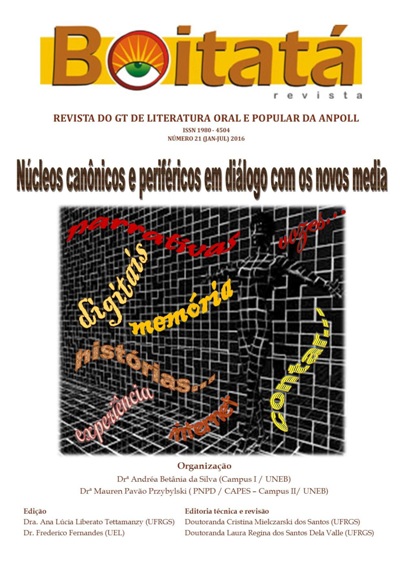The ghetto narrator: marginality and engagement in Ferrèz literature
DOI:
https://doi.org/10.5433/boitata.2016v11.e31265Keywords:
Segregation, Ghetto, Marginal literature, Ferréz,Abstract
This article begins by the polemic involving the self-declared marginality of writers from the periphery regimented by Ferréz. After that, it searches to contextualize the movement and points out the rules of its manifest. And, yet in the introductory part, it details the conception of marginality contained in the aggressive speech, the symbolic layout of breaking the door instead of asking for passage, taking the word (written) of assault. Opposed to distrust and resistance concerning the self-declared marginality, the article, then, proposes as an analysis key a term taken from its own manifest: ghetto. In that order, it treats the reality of Capão Redondo, a poor district of São Paulo city, where Ferréz grew up and still lives, including the northeastern migration history, segregation and violence. Soon later, it becomes the theoretical reference elaborated by the French sociologist Löic Wacquant, who defines ghetto from both sides, as the dominating weapon and as the dominated shield. In applying this concept to Capão Pecado work, Ferréz's first novel, the article draws up the concept of being the ghetto narrator: a local narrator, with hybrid language (speaking, slangs, rap and standard rule), engaged in the cause of the periphery.References
CANDIDO, Antonio. Na noite enxovalhada. In: ANTÔNIO, João. Contos reunidos. São Paulo: Cosac Naify, 2012, p. 577-582.
CORRÊA, Sílvia. Barracos tomam 13% do Capão Redondo. Folha de S. Paulo, 12 fev. 2003, Caderno Cotidiano, p. C3, 2003.
ESLAVA, Fernando Villarraga. Literatura marginal: o assalto ao poder da escrita. In: Estudos de literatura brasileira contemporânea, Brasília, n. 24, p. 35-51, 2004.
FERRÉZ. Capão Pecado. São Paulo: Labortexto Editorial, 2000.
FERRÉZ. Capão Pecado. Rio de Janeiro: Objetiva, 2005a.
FERRÉZ. Terrorismo literário. In: FERRÉZ. Literatura marginal: talentos da escrita periférica. Rio de Janeiro: Agir, 2005c, .p. 9-14.
FERRÉZ (Org.). Literatura marginal: talentos da escrita periférica. Rio de Janeiro: Agir, 2005b.
MANO BROWN. A número 1 sem troféu. In: FERRÉZ. Capão Pecado. São Paulo: Labortexto Editorial, 2000, .p. 23-24.
MANSO, Bruno Paes. Crescimento e queda dos homicídios em SP entre 1960 e 2010: uma análise dos mecanismos da escolha homicida e das carreiras no crime. (manuscrito) 2012. Tese (Doutorado em Ciências Políticas) - Departamento de Ciências Políticas, Universidade de São Paulo, São Paulo. 2012.
MARCOS, Plínio. Na barra do Catimbó. São Paulo: editora Parma, 1982.
NASCIMENTO, Érica Peçanha do. Vozes marginais na literatura. Rio de Janeiro: Aeroplano, 2009.
SCHWARZ, Roberto. Cidade de Deus. In: Sequências brasileiras (ensaios). São Paulo: Companhia das Letras, 1999, p. 163-171.
SÜSSEKIND, Flora. Desterritorialização e forma literária: literatura brasileira contemporânea e experiência urbana. Revista Literatura e Sociedade (Dept. de Teoria Literária e Literatura Comparada da USP), São Paulo, n. 8, p. 60-81, 2005.
WACQUANT, Loïc. O que é gueto? Construindo um conceito sociológico. Revista de sociologia política, Curitiba, n. 23, p. 155-164, 2004.
WACQUANT, Loïc. As duas faces do gueto. Tradução de Paulo Cezar Castanheira. São Paulo: Boitempo, 2008.
Downloads
Published
How to Cite
Issue
Section
License
Copyright (c) 2016 Boitatá

This work is licensed under a Creative Commons Attribution 4.0 International License.
Boitatá esta licenciada com CC BY sob essa licença é possível: Compartilhar - copiar e redistribuir o material em qualquer suporte ou formato. Adaptar - remixar, transformar, e criar a partir do material, atribuindo o devido crédito e prover um link para a licença e indicar se mudanças foram feitas.




















